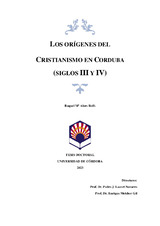Mostrar el registro sencillo del ítem
Los orígenes del Cristianismo en "Corduba" (siglos III y IV)
| dc.contributor.advisor | Lacort Navarro, Pedro José | |
| dc.contributor.advisor | Melchor Gil, Enrique | |
| dc.contributor.author | Alors Reifs, Raquel | es_ES |
| dc.date.accessioned | 2023-10-10T07:03:06Z | |
| dc.date.available | 2023-10-10T07:03:06Z | |
| dc.date.issued | 2023 | |
| dc.identifier.uri | http://hdl.handle.net/10396/26014 | |
| dc.description.abstract | En este trabajo se trata de profundizar en el conocimiento de los primeros tiempos del cristianismo en Corduba, concretamente los siglos III y IV. Partiendo del análisis de las escasas fuentes literarias, la documentación epigráfica y los testimonios arqueológicos, se ofrece una visión de la que fue una ciudad en transición entre la civitas romana clásica y la civitas christiana y del papel desempeñado en dicha transformación por el cristianismo. Se estudian distintos factores de la ecclesia cordubensis de entonces: territorio diocesano, episcopologio –haciendo especial hincapié en la descollante figura del obispo Osio-, aristocracia, mujer y la determinante figura de los mártires, así como la realidad económica eclesiástica y la incidencia del cristianismo en la topografía cultual y funeraria urbanas, con especial atención al conjunto arqueológico de Cercadilla, interpretado cono sede del vicarius de la dioecesis Hispaniarum y, posteriormente, como centro cristiano de culto martirial en conmemoración de San Acisclo. | es_ES |
| dc.description.abstract | This work tries to deepen the knowledge of the early days of Christianity in Corduba, specifically the 3rd and 4th centuries. Based on the analysis of the few literary sources, the epigraphic documentation and the archaeological testimonies, it offers a vision of what was a city in transition between the classical Roman civitas and the civitas christiana, and the role played in said transformation by Christianity. Different factors of the ecclesia cordubensis of that time are studied: diocesan territory, episcopology -with special emphasis on the outstanding figure of Bishop Osio-, aristocracy, women and the determining figure of the martyrs, as well as the ecclesiastical economic reality and the incidence of Christianity in the urban cult and funerary topography, with special attention to the archaeological complex of Cercadilla, interpreted as the seat of the vicarious of the dioecesis Hispaniarum and, later, as a Christian center of martyrial worship in commemoration of San Acisclo. | es_ES |
| dc.format.mimetype | application/pdf | es_ES |
| dc.language.iso | spa | es_ES |
| dc.publisher | Universidad de Córdoba, UCOPress | es_ES |
| dc.rights | https://creativecommons.org/licenses/by-nc-nd/4.0/ | es_ES |
| dc.subject | Cristianismo | es_ES |
| dc.subject | Siglo III | es_ES |
| dc.subject | Siglo IV | es_ES |
| dc.subject | Fuentes | es_ES |
| dc.subject | Arqueología | es_ES |
| dc.subject | Epigrafía | es_ES |
| dc.subject | Corduba | es_ES |
| dc.title | Los orígenes del Cristianismo en "Corduba" (siglos III y IV) | es_ES |
| dc.title.alternative | The origins of christianity in "Corduba" (Third and Fourth centuries) | es_ES |
| dc.type | info:eu-repo/semantics/doctoralThesis | es_ES |
| dc.rights.accessRights | info:eu-repo/semantics/openAccess | es_ES |

